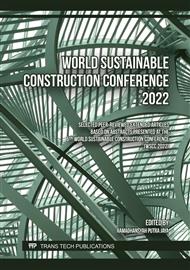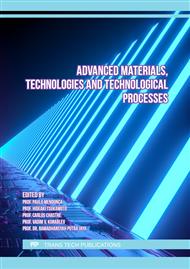[1]
H. Klee, "Briefing: The Cement Sustainability Initiative," in Proceedings of the Institution of Civil Engineers-Engineering Sustainability, 2004, vol. 157, no. 1, pp.9-11: Thomas Telford Ltd.
DOI: 10.1680/ensu.2004.157.1.9
Google Scholar
[2]
Y. Zhang, W. Luo, J. Wang, Y. Wang, Y. Xu, and J. Xiao, "A review of life cycle assessment of recycled aggregate concrete," Construction and Building Materials, vol. 209, pp.115-125, 2019/06/10/ 2019.
DOI: 10.1016/j.conbuildmat.2019.03.078
Google Scholar
[3]
K. P. Verian, W. Ashraf, and Y. Cao, "Properties of recycled concrete aggregate and their influence in new concrete production," Resources, Conservation and Recycling, vol. 133, pp.30-49, 2018/06/01/ 2018.
DOI: 10.1016/j.resconrec.2018.02.005
Google Scholar
[4]
J. de Brito and F. Agrela, New trends in eco-efficient and recycled concrete. Woodhead Publishing, 2018.
Google Scholar
[5]
H. Al-Bayati, S. Tighe and J. Achebe, Influence of recycled concrete aggregate on volumetric properties of hot mix asphalt," Resources, Conservation & Recycling, vol. 130, pp.200-214, 2018.
DOI: 10.1016/j.resconrec.2017.11.027
Google Scholar
[6]
L. Zhu and Z. Zhu, "Reuse of clay brick waste in mortar and concrete," Advances in Materials Science and Engineering, vol. 2020, p.6326178, 2020.
DOI: 10.1155/2020/6326178
Google Scholar
[7]
R. Jin, H. Yuan, and Q. Chen, "Science mapping approach to assisting the review of construction and demolition waste management research published between 2009 and 2018," Resources, Conservation and Recycling, vol. 140, pp.175-188, 2019.
DOI: 10.1016/j.resconrec.2018.09.029
Google Scholar
[8]
R. Islam, T. H. Nazifa, A. Yuniarto, A. S. Uddin, S. Salmiati, and S. Shahid, "An empirical study of construction and demolition waste generation and implication of recycling," Waste Management, vol. 95, pp.10-21, 2019.
DOI: 10.1016/j.wasman.2019.05.049
Google Scholar
[9]
H. Wu, J. Xiao, C. Liang, and Z. Ma, "Properties of cementitious materials with recycled aggregate and powder both from clay brick waste," Buildings, vol. 11, no. 3, p.119, 2021.
DOI: 10.3390/buildings11030119
Google Scholar
[10]
Q. Tang, Z. Ma, H. Wu, and W. Wang, "The utilization of eco-friendly recycled powder from concrete and brick waste in new concrete: A critical review," Cement and Concrete Composites, vol. 114, p.103807, 2020.
DOI: 10.1016/j.cemconcomp.2020.103807
Google Scholar
[11]
K. Rashid, E. U. Haq, M. S. Kamran, N. Munir, A. Shahid, and I. Hanif, "Experimental and finite element analysis on thermal conductivity of burnt clay bricks reinforced with fibers," Construction and Building Materials, vol. 221, pp.190-199, 2019.
DOI: 10.1016/j.conbuildmat.2019.06.055
Google Scholar
[12]
M. U. Rehman, M. Ahmad, and K. Rashid, "Influence of fluxing oxides from waste on the production and physico-mechanical properties of fired clay brick: A review," Journal of Building Engineering, vol. 27, p.100965, 2020.
DOI: 10.1016/j.jobe.2019.100965
Google Scholar
[13]
Y. Zhao, J. Gao, F. Chen, C. Liu, and X. Chen, "Utilization of waste clay bricks as coarse and fine aggregates for the preparation of lightweight aggregate concrete," Journal of Cleaner Production, vol. 201, pp.706-715, 2018.
DOI: 10.1016/j.jclepro.2018.08.103
Google Scholar
[14]
Z. Ge, Y. Wang, R. Sun, X. Wu, and Y. Guan, "Influence of ground waste clay brick on properties of fresh and hardened concrete," Construction and Building Materials, vol. 98, pp.128-136, 2015.
DOI: 10.1016/j.conbuildmat.2015.08.100
Google Scholar
[15]
B. E. 12350-2-2009., " Testing Fresh Concrete. Slump-test," (2009).
Google Scholar
[16]
BS EN 12390-3., "Testing hardened concrete - Part 3: Compressive strength of test specimens ," (2009).
Google Scholar
[17]
BS 1881-122, "Concrete testing: method for determination of water absorption.," 1983.
Google Scholar
[18]
A. Singh, S. Arora, V. Sharma, and B. Bhardwaj, "Workability retention and strength development of self-compacting recycled aggregate concrete using ultrafine recycled powders and silica fume," Journal of Hazardous, Toxic, and Radioactive Waste, vol. 23, no. 4, p.04019016, 2019.
DOI: 10.1061/(asce)hz.2153-5515.0000456
Google Scholar
[19]
O. Olofinnade and J.Ogara, " Workability, strength, and microstructure of high strength sustainable concrete incorporating recycled clay brick aggregate and calcined clay," Cleaner Engineering and Technology, vol. 3, pp.100123-2021.
DOI: 10.1016/j.clet.2021.100123
Google Scholar
[20]
M. J. Miah, S. U. Sagar, S. C. Paul, and A. J. Babafemi, "Feasibility of using recycled burnt clay brick waste in cement-based mortar: mechanical properties, durability, and residual strength after exposure to elevated temperatures," International Journal of Civil Engineering, vol. 19, no. 9, pp.1055-1069, 2021.
DOI: 10.1007/s40999-021-00623-x
Google Scholar
[21]
A. M. Neville "Properties of Concrete," Longman, London, UK, 2011.
Google Scholar
[22]
A. Tareq Noaman, G. Subhi Jameel, and S. K. Ahmed, "Producing of workable structural lightweight concrete by partial replacement of aggregate with yellow and/or red crushed clay brick (CCB) aggregate," Journal of King Saud University - Engineering Sciences, vol. 33, no. 4, pp.240-247, 2021.
DOI: 10.1016/j.jksues.2020.04.013
Google Scholar



